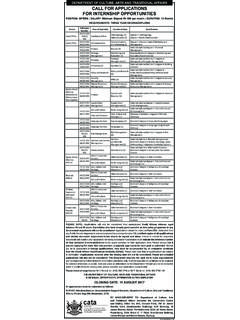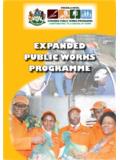Transcription of The Contribution of Culture to Regeneration in the …
1 THE Contribution OF Culture TO Regeneration IN THE UK: A REVIEW OF EVIDENCE A report to the department for Culture Media and Sport Graeme Evans and Phyllida Shaw January 2004 _____ The Contribution of Culture to Regeneration in The UK: A Report to the DCMS - Evans and Shaw, LondonMet, 2004 Contents 1. The scope of this review 2. Terms, definitions, models and measures 3. An overview of the evidence of Culture s Contribution to Regeneration 4. Evidence-based case studies of Culture s Contribution to Regeneration 5. Gaps in the evidence and the reasons for those gaps 6. Recommendations for future action 7. Bibliography 8.
2 Footnotes _____ The Contribution of Culture to Regeneration in the UK: A Report to the DCMS - Evans and Shaw, LondonMet, 2004 11. The scope of this review My own blunt evaluation of Regeneration programmes that don t have a Culture component is they won t work. Communities have to be energised, they have to be given some hope, they have to have the creative spirit released (Robert Hughes, Chief Executive of Kirklees Council, 1998). Introduction This review was commissioned by the department for Culture Media and Sport (DCMS) to inform the preparation of a policy document on the Contribution of cultural activity to Regeneration (see 2.)
3 Terms, definitions, models and measures). It has been written primarily as a briefing for DCMS officials. Carried out over the summer 2003, responses and coverage of published and in press information may not be as full as a longer research period would have allowed, however the review has been extensive within the Culture and Regeneration sphere. New reports and publications are emerging almost daily, in part due to the raised interest in and awareness of the subject, and these should be continually reviewed as policy formulation and implementation is undertaken. In addition to setting out its own objectives for Culture and Regeneration , DCMS is working to increase awareness within other Government departments of the potential Contribution of cultural activity to their Regeneration programmes.
4 The indicators of Regeneration most commonly referred to in this paper are those already widely used by Government in the context of neighbourhood renewal, social inclusion and community cohesion: reduced levels of crime, increased health and well-being, increased educational attainment, reduced unemployment, greater community cohesion, greater environmental quality and quality of life (or liveability). Our brief has been to produce: a stock-take of evidence-based literature on the impact of Culture on social, economic and environmental (physical) Regeneration in the UK an analysis of the limitations of the evidence examples of best practice in the design and delivery of projects examples of best practice in measurement of impacts recommendations in the light of our findings The Government is committed to evidence-based policy-making and our focus has therefore been upon published evidence.
5 There is a substantial amount of reflective and documentary-style writing on this subject that has not been included. The cumulative value of such work, however, does need to be acknowledged, especially where similar conclusions have been reached about the relationship of cultural _____ The Contribution of Culture to Regeneration in the UK: A Report to the DCMS - Evans and Shaw, LondonMet, 2004 2activity to Regeneration . Illustrative examples drawn from such sources can also help to raise awareness of the different ways in which cultural activity can be used in Regeneration projects. In the past, Regeneration programmes were too often developed without reference to, or inclusion of incumbent arts and cultural groups, although this situation does seem to be improving with more integrated and inclusive planning ( local cultural strategies, Local Development Frameworks, Community Strategies, Local Strategic Partnerships), and greater awareness by cultural organisations of their involvement and value in the Regeneration process.
6 Methodology The DCMS brief has therefore been to undertake a review of published evidence and in particular to assess the value and validity of this evidence. This has been achieved within the time available, through a literature search via online and bibliographic sources (university and specialist libraries, academic and professional journals), and a call to all English Regional Government Offices (RGOs) and cultural officers for reports and impact studies on the study theme. Some RGOs also contacted those responsible for arts and Culture ( festivals, heritage, cultural tourism) in their region, which produced some useful information and studies in progress.
7 Evidence and case study material has been analysed by the main impact area and type - economic, environmental/physical and social; by the methodology used; and by the main art form/cultural activity concerned. Publications were divided between those which had a scientific research base or methodology - whether empirical, using quantitative and/or qualitative surveys - and those which were illustrative and largely descriptive case studies. These have been distinguished in the Bibliography (7.) with R denoting Research and I denoting Illustrative . A small number of case studies have been selected as illustrations which provide evidence and good practice in Culture s engagement with the Regeneration process.
8 These include examples across a range of cultural activities, locations and arising impacts. The robustness of the research evidence and findings has been assessed in terms of both the author s approach and conclusions, and the degree of peer review and strength of evidence. The latter includes the timescale and sample size of an impact study, as well as how far the study and conclusions might be transferable or generalisable in the context of other evidence in the field. Positive and negative evidence and critiques have been considered. The extent to which research and case study material indicates an example of good practice in the design and delivery of cultural projects and in impact evaluation and measurement, has been assessed on a case by case basis.
9 Overall, where particular trends in evaluation and outcomes are evident, these have been used to make suggestions as to which of these are the most important in ensuring successful Culture -led Regeneration projects. We have not however undertaken any primary research or site visits, and our analysis is based entirely on the evidence available. _____ The Contribution of Culture to Regeneration in the UK: A Report to the DCMS - Evans and Shaw, LondonMet, 2004 32. Terms, definitions, models and measures In the late 1980s, the publication by the Policy Studies Institute of a series of reports on the economic importance of the arts in Merseyside, Glasgow and Ipswich, followed by single volume on Great Britain1 reflected a change in the vocabulary used by government and its agencies to describe a sector habitually referred to as the arts.
10 Also in the 1980s, the production of early examples of cultural industries strategies in, among other places, London, Liverpool, Manchester and Sheffield, signalled a growing recognition of the economic dimensions of the arts, including their regenerative and distributive effects 2. By the early 1990s, the sector , industry or industries suffix was in common use, although many artists and arts managers continued to dislike the association with the vocabulary of an industrial economy. The PSI was among the first to use the term cultural industries in publications that were widely read by arts managers, funders and policy makers and references to the arts and cultural industries began to appear more frequently.







